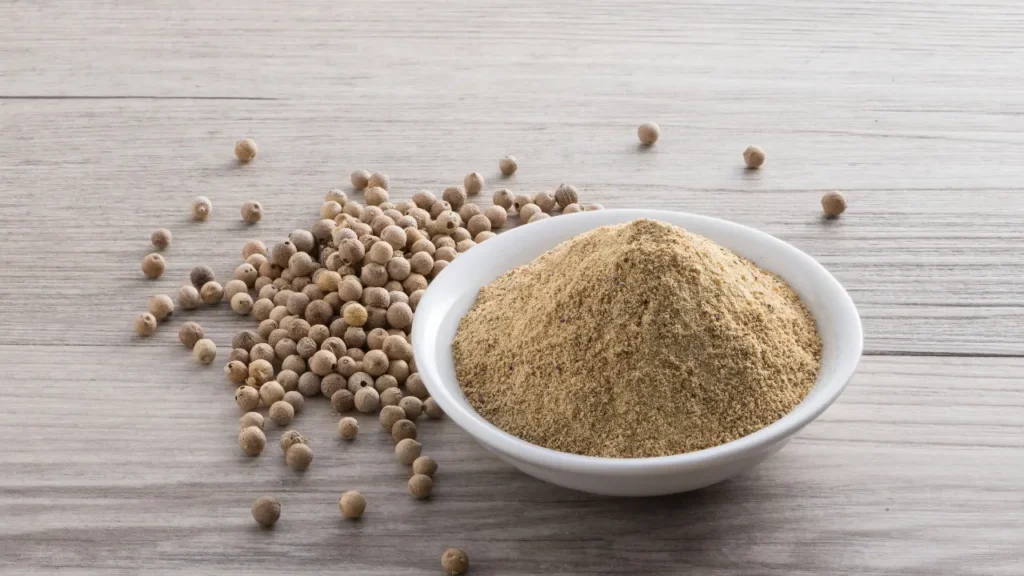The piper nigrum plant, which produces white pepper, has long been used as a spice in a variety of dishes and medicinal remedies. The plant’s pungent flavor and many health advantages are due to the bio-active component piperine, a primary alkaloid contained in it. With a focus on the chemical and physiological properties underlying its effects on the body and brain, this article aims to provide a thorough examination of the nature, health benefits, ideal dosage, side effects, potential substance interactions, and responsible use of white pepper as a nutritional supplement.
You May Also Like:
Battle of the Brain Boosters: Brain MD Omega 3 Power vs. Kori Krill Oil Mind & Body
BANABA: Benefits, Dosage, Side Effects, Drug Interactions, And Other Important Information
White Pepper: Benefits, Dosage, Side Effects, Drug Interactions, And Other Important Information is an original (NootropicsPlanet) article.
Nature of White Pepper
The dried, fully developed fruits of the piper nigrum plant are used to make white pepper. A method called retting, removes the fruit’s exterior pericarp while keeping the interior seed in situ. White pepper is produced by drying the seeds. Piperine, an alkaloid component that makes up roughly 5-9% of white pepper’s dry weight, is responsible for the spicy flavor. Volatile oils, flavonoids, and phenolic compounds are other bio-active components in white pepper that can contribute to its therapeutic benefits.
Health Benefits of White Pepper
Internal Health
By encouraging the release of gastric fluids and boosting the activity of digestive enzymes, white pepper has historically been used to help digestion. By decreasing the activity of P-glycoprotein and cytochrome P450 enzymes, piperine, the main active ingredient in white pepper, enhances the bio-availability of nutrients. Improved absorption of vital nutrients like vitamins, minerals, and amino acids is made possible by this method.
Antioxidant Characteristics
White pepper contains phenolic substances with antioxidant properties such as ferulic acid and vanillic acid. By disarming free radicals, these antioxidants assist in defending the body against oxidative stress, minimizing cellular damage, and lowering the risk of chronic illnesses including cancer and cardiovascular disorders.
Anti-inflammatory Effects
By preventing the creation of pro-inflammatory cytokines including interleukin-6 and tumor necrosis factor-alpha, piperine demonstrates anti-inflammatory ablilities. These outcomes could help treat inflammatory diseases including arthritis and asthma.
Effects of Neuroprotection
According to research, piperine contains neuroprotective properties that may help with the prevention and treatment of neuro-degenerative illnesses including Parkinson’s and Alzheimer’s. A key neurotransmitter for cognitive function, acetylcholine, is broken down by the enzyme acetylcholinesterase, which is thought to be how piperine exerts its neuro-protective benefits. In addition, piperine can control antioxidant enzyme activity, lowering oxidative stress in brain tissues.

Chemistry of White Pepper
White pepper contains piperine, an alkaloid with the molecular formula C17H19NO3, which is the main bio-active component. It is a crystalline chemical that is a member of the amide class and is distinguished by having a carbonyl group (C=O) joined to a nitrogen atom. A piperidine ring, a pyrrolidine ring, and an aromatic benzene ring make up the structure of piperine, which combined give it its distinctive pungent smell and bio-activity.
Physiological Properties of White Pepper
Internal Health
By controlling the activity of enzymes and transporters involved in drug metabolism and absorption, piperine enhances the bio-availability of nutrients. It stops P-glycoprotein from functioning as an efflux transporter, which prevents medicines and other chemicals from being absorbed by pumping them back into the digestive system. Increased absorption of nutrients and bio-active substances is the outcome of piperine’s inhibition of P-glycoprotein. Additionally, the liver’s cytochrome P450 enzymes, which metabolize a variety of compounds, including medicines and nutrients, are inhibited by piperine. Piperine can raise the plasma concentrations of co-administered drugs, improving their bio-availability and effectiveness by blocking certain enzymes.
Antioxidant Characteristics
Free radicals can be neutralized by phenolic substances contained in white pepper, such as ferulic acid and vanillic acid, which have antioxidant effects. Free radicals are very reactive molecules with unpaired electrons that can harm biomolecules including DNA, proteins, and lipids by oxidation. These phenolic compounds’ antioxidant action is related to their capacity to stabilize free radicals by giving them hydrogen atoms or electrons, limiting further oxidative damage.
Anti-inflammatory Effects
By regulating the synthesis of pro-inflammatory cytokines and activating nuclear factor-kappa B (NF-B), a transcription factor involved in the control of immunological and inflammatory responses, white pepper exerts its anti-inflammatory properties. By inhibiting the activation of NF-B, white pepper reduces the production of pro-inflammatory cytokines including interleukin-6 (IL-6) and tumor necrosis factor-alpha (TNF-). white pepper can help treat disorders associated with inflammation by lowering the production of these cytokines.
Effects of Neuroprotection
Due to its ability to inhibit acetylcholinesterase, an enzyme that degrades the neurotransmitter acetylcholine in the synaptic cleft, white pepper is thought to have neuroprotective properties. White pepper boosts the levels of acetylcholine in the brain, which is essential for learning, memory, and cognitive function by inhibiting acetylcholinesterase. Additionally, white pepper can control the activity of antioxidant enzymes like superoxide dismutase and catalase in the brain tissues, lowering oxidative stress and avoiding neuronal damage.
White pepper shows potential as a dietary supplement with a variety of therapeutic uses.

Optimal Dosage of White Pepper
Various individual characteristics, including your age, overall health status, and the particular health issue being treated, affect the ideal amount of white pepper. As a general rule, it is thought that most individuals can safely consume 5–10 mg of white pepper daily, which is equal to about 100–200 mg of white pepper. Before adding any dietary supplement, including white pepper, to your regimen, it is imperative to get medical advice.
Side Effects of White Pepper
Eating too much white pepper is not generally recommended, and it can have negative effects. Gastrointestinal irritation, such as heartburn, nausea, or diarrhea, is one of the possible side effects. When consuming white pepper, anyone with a history of stomach ulcers or those using drugs for acid reflux should use caution. White pepper can also induce allergic reactions, which show up as skin rashes, itching, or breathing problems.

Potential Substance Interactions with White Pepper
Negative Drug Reactions
White pepper’s piperine has been demonstrated to modify how some drugs are metabolized, which could change how effective a drug is or raise the possibility of side effects. Cytochrome P450 enzymes, which are involved in the metabolism of many medicines, are inhibited by piperine. Drugs that are substrates for these enzymes may have enhanced plasma concentrations and bio-availability as a result of this interaction. Examples include calcium channel blockers (such as nifedipine), anticonvulsants (such as phenytoin), and anticoagulants (such as warfarin).
Food Interactions
Curcumin, a bio-active component included in turmeric, can be better absorbed when consumed with white pepper. By preventing the liver and digestive system from metabolizing curcumin, piperine improves the bio-availability of the substance. For those looking to maximize the health advantages of curcumin, this interaction might be helpful, but it’s crucial to take into account the possibility of an elevated risk of negative effects or nutritional poisoning.
Best Responsible Uses of White Pepper
Progressive Incorporation
It is suggested to start with tiny doses of white pepper and gradually increase the consumption to determine personal tolerance and reduce any potential negative effects.
Healthcare Professional Consultation
For anyone with pre-existing medical disorders, women who are pregnant or nursing, or those who take drugs that could interact with white pepper, it is crucial to speak with a healthcare provider before using it as a nutritional supplement.
Tracking Health Status
When introducing white pepper or any other nutritional supplement into your diet, regular monitoring of your overall health state is imperative, including routine blood testing and check-ups. This procedure assures the safe and responsible use of white pepper and makes it possible to identify any potential negative effects or interactions.
White Pepper:
Conclusion
White pepper has been known to have significant benefits on overall health and wellness. The information in this article suggests the many health advantages of white pepper, highlighting its potential as a dietary supplement with a variety of therapeutic uses. However, it is important to always talk to your doctor before starting white pepper supplements.

References:
- Health benefits and potential applications of piperine. Retrieved from: https://www.sciencedirect.com/science/article/pii/S2221169115000647
- Piperine and its role in chronic diseases. Retrieved from: https://www.ncbi.nlm.nih.gov/pmc/articles/PMC4979255/
Important Note: The information contained in this article is for general informational purposes only, and should not be construed as health or medical advice, nor is it intended to diagnose, prevent, treat, or cure any disease or health condition. Before embarking on any diet, fitness regimen, or program of nutritional supplementation, it is advisable to consult your healthcare professional in order to determine its safety and probable efficacy in terms of your individual state of health.
Regarding Nutritional Supplements Or Other Non-Prescription Health Products: If any nutritional supplements or other non-prescription health products are mentioned in the foregoing article, any claims or statements made about them have not been evaluated by the U.S. Food and Drug Administration, and such nutritional supplements or other health products are not intended to diagnose, treat, cure, or prevent any disease.


